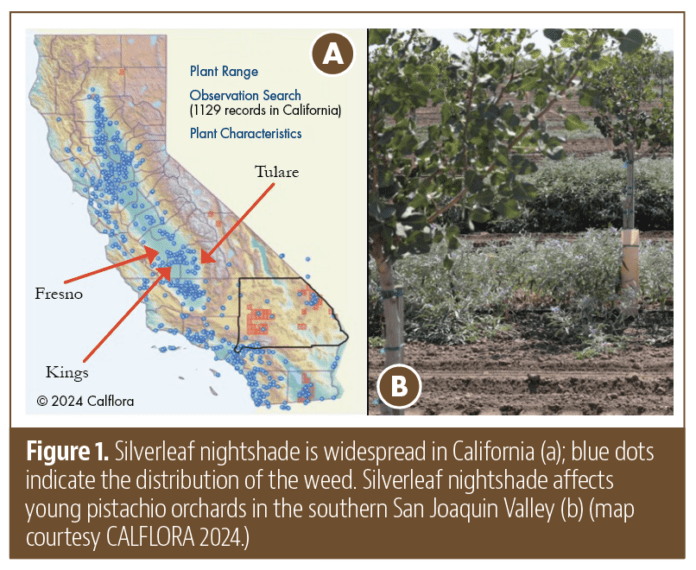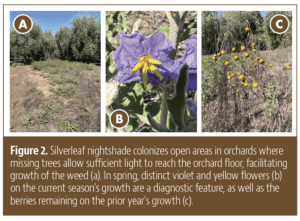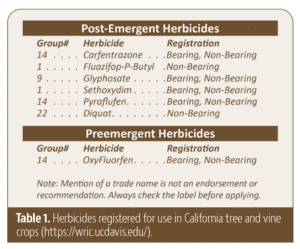
Silverleaf nightshade, Solanum elaeagnifolium, is a perennial weed native to South America, Mexico and the southwestern and southern U.S. It is widespread in California where it affects diverse agricultural and non-agricultural systems, including orchards, rangeland, pasture, roadsides and disturbed areas. Because it readily adapts to high temperatures, low rainfall and saline and drought conditions, silverleaf nightshade is a problem in orchard systems. It is widely distributed in California and is currently affecting both young and mature orchards (Figures 1 and 2). Silverleaf nightshade is currently affecting young pistachio orchards in western Fresno and Kings Counties. In Tulare County, it is found in pistachio orchards that were planted in unmanaged fallow land or in fields near roadsides where it is commonly found. In mature orchards, missing trees create gaps in the canopy, thus allowing light penetration to the orchard floor and enabling establishment of resident populations of silverleaf nightshade (Figure 2a). In orchard systems, it competes with developing trees for resources, while the toxic glycoalkaloid compounds in the leaves and berries pose an additional threat to livestock and other animals if consumed.

Identification
Silverleaf nightshade is an herbaceous, perennial weed belonging to the Solanaceae family along with other weeds, including black nightshade (Solanum nigrum), hairy nightshade (Solanum physalifolium) and horsenettle (Solanum carolinense). The mature plant is generally 1 to 3 ft high and can be readily identified by the small yellow to brown berries (~0.5 inch in diameter) and silver-gray foliage that often contains prickles (Figure 2c). The flowers are violet with distinct yellow centers (Figure 2b).
Life Cycle
Silverleaf nightshade is difficult to control because of its perennial life cycle in California. It emerges in early spring to late summer, with new plants growing from both seed and rhizomes. It flowers from summer to early fall, generating around 200 small fruits on each plant. Each fruit may contain 24 to 150 seeds. The seeds may be dispersed by birds that have consumed the fruit or by the movement of soil. The plant is also disseminated by movement of soil containing rhizome fragments. The mature plant dies back with the first frost, but the rhizomes survive underground.
Impacts
The weed competes with young orchard trees for resources, such as water, light and nutrients. If left unmanaged, silverleaf nightshade can also interfere with irrigation operations and potentially reduce vigor of young trees. Since silverleaf nightshade can adapt to alkaline and saline soils, it has the potential to outcompete many of the summer annual weeds and become the dominant weed in a population.
Management
Silverleaf nightshade is difficult to control in orchards. Tillage is not recommended because the movement of rhizome fragments may result in spread of the weed across orchards. Mowing can be an effective strategy to prevent weeds from setting seed. Flail mowers are often used in orchards and vineyards to mow weeds in between tree rows. After mowing, however, new silverleaf nightshade shoots may sprout from underground rhizomes, regenerating the weed. Despite the efficacy of mowing, most commercial mowers will miss weeds in the tree row. Hand weeding can be used to remove some of the weeds around the trees, but precautions need to be taken to protect the skin because mature plants are covered with reddish prickles. Weeding tools, such as shovels and hula hoes, are effective but can damage surface drip hoses if the user is not careful.

Herbicides can be an effective weed management method to control silverleaf nightshade in different tree and vine crops. There are six post-emergent herbicides and one preemergent herbicide registered for use in trees and vines in California (Table 1). Preemergent herbicides are normally applied during the dormant season and most only control weeds before they germinate. Preemergent herbicides will not control silverleaf nightshade that emerges from rhizomes in the summer. Post-emergent herbicides can be used to control silverleaf nightshade that emerges in the summer and early fall before harvest. In the summer months, a combination of mowing and the use of post-emergent herbicides can kill the aboveground tissues of silverleaf nightshade and deplete the belowground propagules in soil. Post-emergent herbicides need adjuvants, such as nonionic surfactants and crop and seed oils, to increase their efficacy.
Specific to pistachio, there are 12 preemergent and 13 post-emergent herbicides with different modes of action that are registered. Pendimethalin, rimsulfuron, mesotrione, flumioxazin, isoxaben and flazasulfuron are herbicides that have great control over black and hairy nightshade. Isoxaben can suppress silverleaf nightshade but can only be used in pistachios that have been established for at least three years. Glyphosate, glufosinate, pyraflufen-ethyl, paraquat and carfentrazone are post-emergent herbicides with different modes of action that can be used to control different weeds and can be used up to two weeks before harvest. 2, 4-D is another post-emergent herbicide that is registered for use in pistachios but needs to be applied to trees that have been established for at least one year and has a preharvest interval of 60 days. Studies have shown glyphosate and 2, 4-D have excellent control of silverleaf nightshade. Glyphosate is a systemic herbicide that can potentially kill the root and rhizome system of silverleaf nightshade when applied at the correct timing and rate. Furthermore, always consult herbicide labels on information regarding the required adjuvants, preharvest intervals, application rates and maximum applications per season.
Because silverleaf nightshade is a problem in mature olive orchards adjacent to the foothills in Tulare County, UCCE Weed Management Advisor Jorge Angeles (Tulare and Kings counties) recently initiated a study evaluating post-emergence herbicides, alone and in combination, for management of the weed. A suite of 10 treatments was applied in late Spring 2024, and preliminary data on treatment efficacy will be available by late July. Angeles is also interested in establishing a trial in late winter to evaluate efficacy of pre-emergence herbicides for management of silverleaf nightshade in table olives.
Silverleaf nightshade is difficult to control because of its adaptability to diverse agricultural systems, its tolerance to many herbicides and its perennial nature. A combination of cultural practices, such as mowing between tree rows, and implementation of an herbicide program with products containing multiple modes of action should be used to develop an effective management strategy for silverleaf nightshade. Additionally, developing and maintaining field records before planting is a great way to determine the history of a field, and weed surveys in the winter and spring can help determine what weed species are present in a field. Last, to prevent introduction of silverleaf nightshade into orchards, it is important to sanitize tractor equipment and manage the weeds that grow on the field edges or near irrigation canals.















